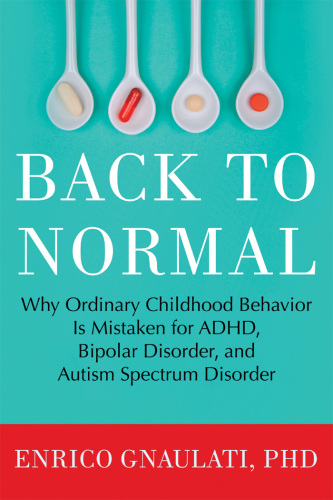
Back to Normal
Why Ordinary Childhood Behavior Is Mistaken for ADHD, Bipolar Disorder, and Autism Spectrum Disorder
کتاب های مرتبط
- اطلاعات
- نقد و بررسی
- دیدگاه کاربران
نقد و بررسی

June 3, 2013
This well-documented work by clinical psychologist Gnaulti explores children’s seemingly abnormal behavior—behavior whose causes are often incorrectly attributed to psychiatric disorders. Perplexed parents and teachers will find helpful information about such behavior, helping them to distinguish between ADHD, ASD, and bipolar disorder, and allowing them to determine when kids are suffering from these disorders and when they are simply on different developmental schedules. Children are increasingly analyzed and diagnosed as early as toddlerhood; the upshot is an epidemic of misdiagnosis, Gnaulti argues, giving children lifelong labels instead of understanding. Each chapter provides case studies and anecdotes describing different approaches to psychological evaluation and treatment. Is a five-year-old who seeks autonomy in kindergarten hyperactive or gifted? Is a preteen who doesn’t pay attention in class and is easily angered bipolar or slow to mature? And is a brainy, willful, adolescent introvert autistic or unchallenged academically? Gnaulti warns that the goal of medicating children should not be to make them docile and help them achieve good grades. He explains why kids act out and the consequences of such behavior. The final chapter, titled “Parenting Tips,” describes roles, rules, and responsibilities that can empower parents and professionals to affect remedial action. This book is a welcome antidote to an alarming trend.

July 15, 2013
A veteran clinical psychologist contends that there is a "pervasive tendency in our society to medicalize children's behavior" and "shy away from trusting our own ability to decipher the ordinary human meanings, motives and developmental reasons for why children act the way they do." While not denying the necessity for medical treatment of psychiatric disorders, Gnaulati urges caution. He cites instances where simple factors such as a lag in social and emotional development, have led to a diagnosis of ADHD and a prescription for Ritalin. Recently, Michigan State University economist Todd Elder found a shocking correlation between kindergarteners' birth dates and their being prescribed ADHD medication. "If a child is behaving poorly," said Elder, "it may simply be because he's 5 and the other kids are 6." Gnaulati believes that too frequently, the norm of acceptable behavior for children has been feminized--e.g., typical roughhousing by boys has become unacceptable. Children who speak out of turn, forget their homework and are easily distracted are difficult for teachers to deal with in overcrowded classrooms. It is easier to explain such behaviors in terms of neuropsychology and medicate them than to look for environmental reasons that can be addressed by traditional methods of psychotherapy and family counseling. Gnaulati gives many examples of misdiagnoses: picky eaters prone to tantrums who were prematurely diagnosed with autism spectrum disorders; attention-seeking children who misbehaved; sleep-deprived adolescents who were depressed and irritable. In some instances, the author finds that creative children may be faulted for their independence and out-of-the-box thinking. Gnaulati makes a strong case that an incorrect diagnosis of behavioral problems can be stigmatizing and that prescription drugs frequently have overlooked, negative side effects. A valuable guide for parents and educators that includes tips on choosing a therapist and parenting strategies.
COPYRIGHT(2013) Kirkus Reviews, ALL RIGHTS RESERVED.

June 1, 2013
Gnaulati, a clinical psychologist with more than two decades of experience providing psychotherapy to children and families, explores the reasons behind the rapid increase in the number of children diagnosed with ADHD, bipolar disorder, and autism spectrum disorders. Citing and comparing a range of clinical studies with his own practice and experience, Gnaulati hypothesizes that the amount of pediatrician "face time" (the average visit being 15 minutes long), combined with financial pressure from pharmaceutical companies, is partially to blame for inaccurate diagnoses. Adding to the problem, he argues, is the lack of education in normal child development for teachers, parents, pediatricians, and other medical and mental health professionals, which has led to a nation of overdiagnosed and -medicated children. He further ascertains that many diagnosed children express some other form of normal temperamental and developmental behaviors. VERDICT Gnaulati has left very little room here for children deserving of the diagnosis, who both need and benefit from medication. However, his arguments are of considerable measure. Highly recommended for parents, caregivers, educators, physicians, and specialists working with children of all ages.--Virginia Johnson, Weymouth P.L., MA
Copyright 2013 Library Journal, LLC Used with permission.

























دیدگاه کاربران